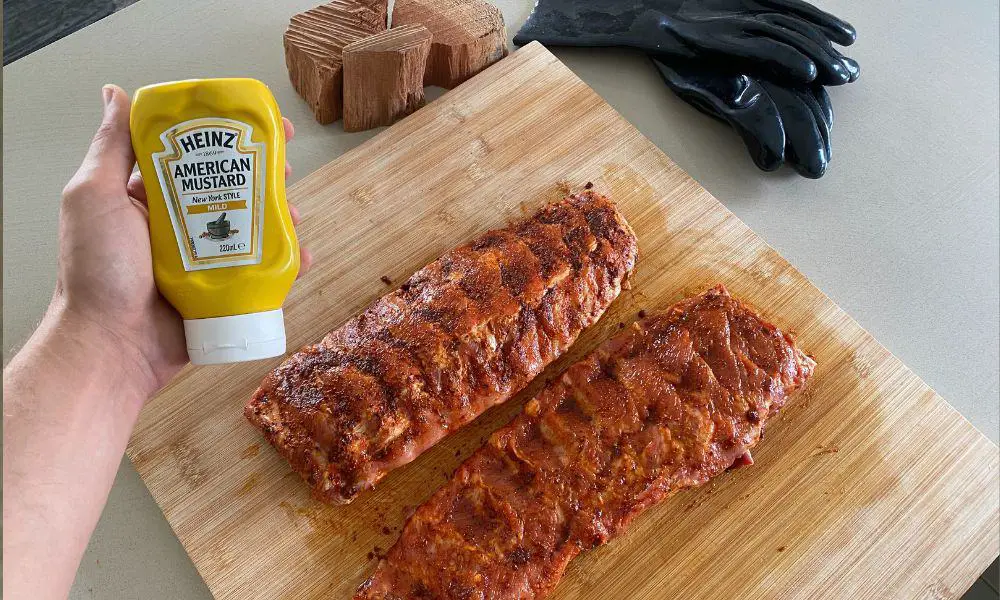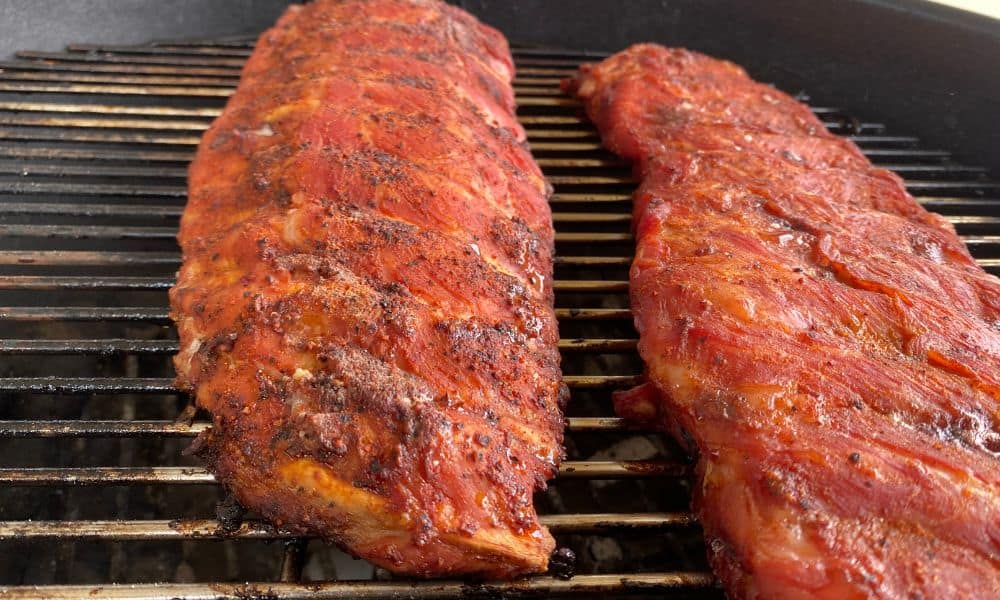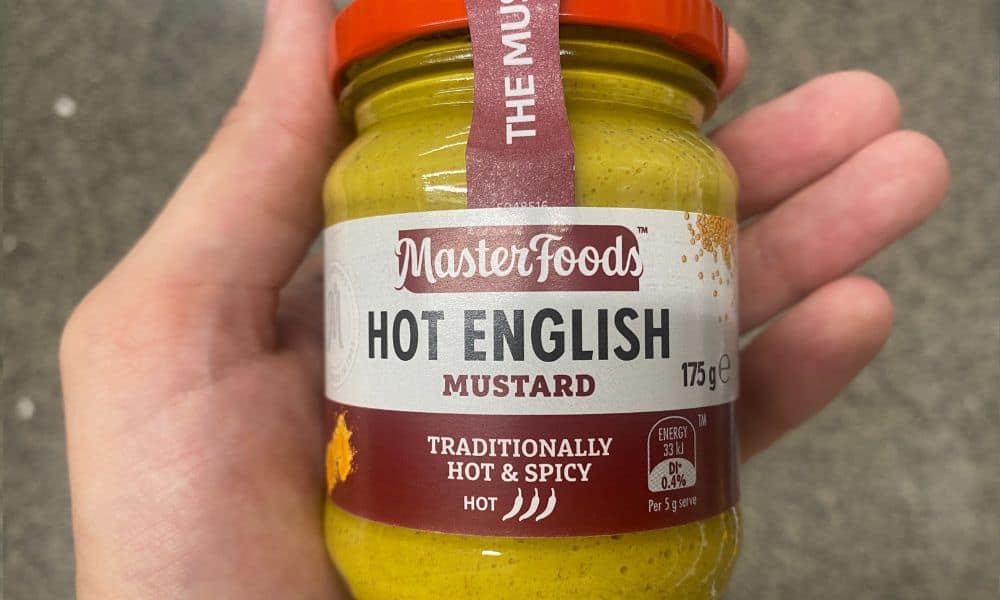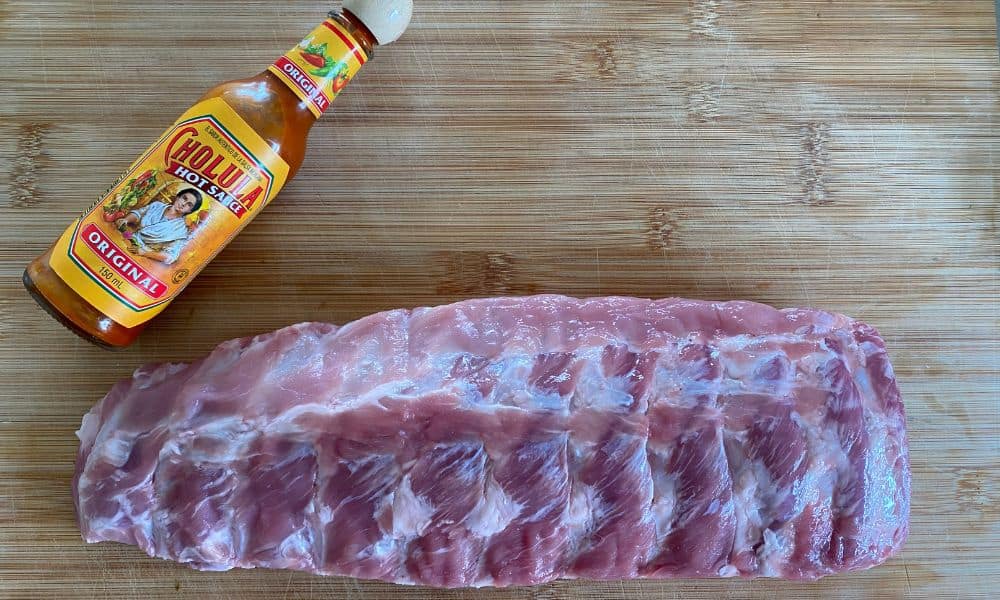If you’ve been around the BBQ game long enough, you’ll know that almost every experienced pitmaster and backyard BBQer puts mustard on their ribs before they apply their dry rub.
But, contrary to popular belief, it’s not all about adding additional flavor. At least not from the mustard anyway!
To better understand this tradition, here’s exactly why mustard is used on ribs, why mustard is the most popular binder for ribs, what the best mustard binders are for ribs, and what other options are viable.
Time to level up your ribs game.

The deliciousness of mustard as a condiment is well known. But it’s usually applied after the cooking process as a topping whether it’s on hot dogs, hot pretzels, or literally anything really.
But when it comes to cooking ribs, it’s used BEFORE the cooking process even takes place, so what gives?
Well in fact mustard is widely used in the BBQ community as a neutral but effective binder helping any dry rub or seasoning to firmly grip onto the ribs.
It’s not about the flavor of the mustard itself, as it’s virtually undetectable once the ribs have been cooked. Instead, the mustard allows maximum dry rub retention and facilitates the bark formation on the ribs.
These are the fundamentals of the binding process.
So Why Mustard?

It’s true, mustard has got to be the most popular and most effective binder for pork ribs. But, why is it so much more common than any other binder?
Well, let’s break it down into all of its mustardy qualities:
- The consistency is important so that it doesn’t drip, run off your ribs, and move around on the ribs when you apply the seasoning.
- The mild flavor is key, as you want to maximize the binding effect without leaving any overpowering taste on the ribs.
- The vinegar base has an extra tenderizing effect on the ribs too!
Not to mention, using mustard as a binder also adds additional moisture to the surface of the ribs, helping things stay tender and actually helps the ribs absorb more smokiness too.
So putting it all together, mustard has the perfect consistency, a mild flavor, and a vinegar base, and overall helps the seasoning stick and form a delectable and mouthwatering bark on the pork ribs.
How Long To Leave Mustard On Ribs Before Dry Rub?
Alright, so you’ve slathered on a good healthy layer of mustard all over your ribs, now what?
Well, you don’t need to wait at all. You can go ahead and apply your dry rub or seasoning.
After all, you want the mustard to still be wet when you apply your dry rub for maximum stickiness to occur.
Sure, leaving the mustard binder on your ribs will allow the vinegar in it to continue to tenderize your ribs, but there’s no harm in applying your dry rub immediately after you’ve applied the mustard.
Once you’ve applied your binder and a generous amount of your desired dry rub or seasoning, you can wait anywhere from a few minutes to 24 hours before smoking or cooking your ribs.
Do You NEED To Use Mustard For Ribs?

Now, before I get bombarded in the comments from BBQ aficionados, I must admit, you don’t NEED to use mustard as a binder for ribs.
Really, you don’t NEED to use a binder at all.
Some pitmasters actually swear by this, claiming mustard disguises the true taste of the pork ribs and will go to any lengths necessary to avoid using any kind of binder. Some will even opt for a dry-brining process instead.
My recommendation: try both and see which you prefer!
Try cooking pork ribs with mustard as a binder and try cooking pork ribs without a binder. You’ll find your own style and flavor profile. That’s the glory of barbecue.
Mustard On Ribs In Oven?
Most of the time when we talk about applying mustard or any binder to ribs, it’s in the context of smoked ribs.
However, mustard will still provide the same desired binding effect on the dry rub whether you’re going to smoke them, grill them, or even roast them in the oven (or finish them in the oven after smoking them).
So, if you’re planning to cook your ribs in the oven, it’s still recommended to slather them up in mustard or another binder and apply your dry rub before you beginning the cooking process!
Best Mustards To Use For Ribs
Using mustard as a binder isn’t ALL about the taste, in fact quite the contrary.
However, this doesn’t mean you can’t use mustard to also deliver an extra layer of flavor to your pork ribs.
So, just like you can choose your favorite seasoning or dry rub, you can also choose your favorite mustard binder.
Of the many mustard binders you could choose from, the notable favorites are:
- Classic American Mustard
- Dijon Mustard
- Hot English Mustard
Classic American Mustard For Ribs
Inexpensive, simple, mild, and neutral. There’s a reason why classic American mustard has got to be the most popular mustard binder of the lot.
If you’re looking to maximize the binding effect, without providing any overpowering mustardy flavors, classic American mustard has you covered.
Plus, there’s no doubt you’ve got some already stashed away somewhere in your pantry!
Dijon Mustard For Ribs

Want a thicker consistency with a much more subtle flavor? Dijon mustard is another perfect pick as a binder for ribs.
Since it’s pretty thick on it’s own, some backyard BBQers actually mix Dijon with a bit of Worcestershire sauce for maximum impact, adding a bit more of an oomph of flavor too.
Don’t sleep on Dijon, folks.
Hot English Mustard For Ribs

For those that love the heat, hot English mustard has you covered.
A nice even consistency, a bit vinegary for some added tenderization of the ribs, and of course, some great deep heat, without being spicy.
It works well when paired with sweeter rubs and sauces, and creates a pretty rich color on your ribs too.
What’s not to like?
Alternative Binders For Ribs
This ones for all those rib-lovers that are looking to try something different, or those that simply dislike the taste, look, or feel of mustard.
After all, applying a binder to your ribs is more about helping the seasoning stick to the rib than adding a specific flavor profile.
Of course, you don’t need to use MUSTARD as your binder, you can choose to use other effective condiments too.
So, there are a handful of other effective binders you can use for ribs, including Worcestershire sauce, mayonnaise, olive oil, or even hot sauce.
Worcestershire Sauce As A Binder For Ribs
Worcestershire sauce is as good on ribs as it is hard to pronounce.
Although it’s a lot thinner and tends to run off the ribs, an even coating followed by a hasty application of dry rub still does the trick.
If you want to go the extra mile, mix Worcestershire sauce with mustard to get the best of both worlds, a nice even consistency, a good dose of vinegar for tenderizing the ribs, and an added savory flavor to boot.
Mayo As A Binder For Ribs

Surprised?
Yes, mayo is an astoundingly good binding agent for ribs. Although it looks funny when you first apply it, once you apply your dry rub and cook your ribs you wouldn’t even guess.
It has a good neutral flavor and great consistency — it’s even used as a binder for smoked turkey!
Hot Sauce As A Binder For Ribs

Did somebody say hot sauce?
Yup, hot sauce is another wild card pick. In fact, it’s one of the few binders that actually doubles as a genuine flavor enhancer too.
I’ve found that vinegar-based hot sauces work best here, and there’s no limit to how spicy you want to go – so long as you can handle the heat!
Olive Oil (+ Other Cooking Oils) As A Binder For Ribs
Although oils won’t provide much from a tenderizing perspective, they can still be used as an effective binder.
What’s more, oil will actually help seal in some of the rib’s moisture during the cooking process too.
From olive oil to avocado oil, to vegetable oil and beyond – most serve as a decent binder alternative for ribs.
What About Ketchup?
As much as I want to say Ketchup is a great binder for ribs, it does have a few downsides which make it a rather unpopular choice.
Ketchup is distinctly sweet, and when it’s been cooking for a long time it can develop a rather unpleasant tangy taste.
Although it does work from a binding agent perspective, helping glue any dry rub to the rib, it’s not commonly used as it can leave behind an unwanted flavor on the ribs once they’re cooked.
What About Applying Mustard After The Dry Rub?
For those that love using mustard as a binder, I would say 95% apply it first, before adding their dry rub.
But, who could forget the 5% of people that just love to do things differently.
There are those that prefer to put their dry rub on first, and then apply mustard on afterward, rubbing it all together into one deliciously flavor-packed slather.
The difference here is that instead of the dry rub clearly being on the outer most layer of the rib, it’s well-mixed in with the mustard.
The results are very much the same, and I couldn’t tell you if you would really tell the difference or not – but some claim they do!
That's A Wrap, Folks!
So applying mustard to your ribs before the dry rub isn’t just for show.
Mustard is probably one of the best binders you can use for ribs, having a perfect consistency, neutral taste, AND being easily accessible.
As a binder, mustard helps keep the dry rub on the rib which plays a huge part in the bark formation and enhances the flavor of the rib during the cooking process.
Of course, it’s not a hard and fast rule, you don’t NEED to use mustard, nor do you need to use a binder at all. But, there’s a damn good reason why it’s so commonly used in the BBQ scene!

